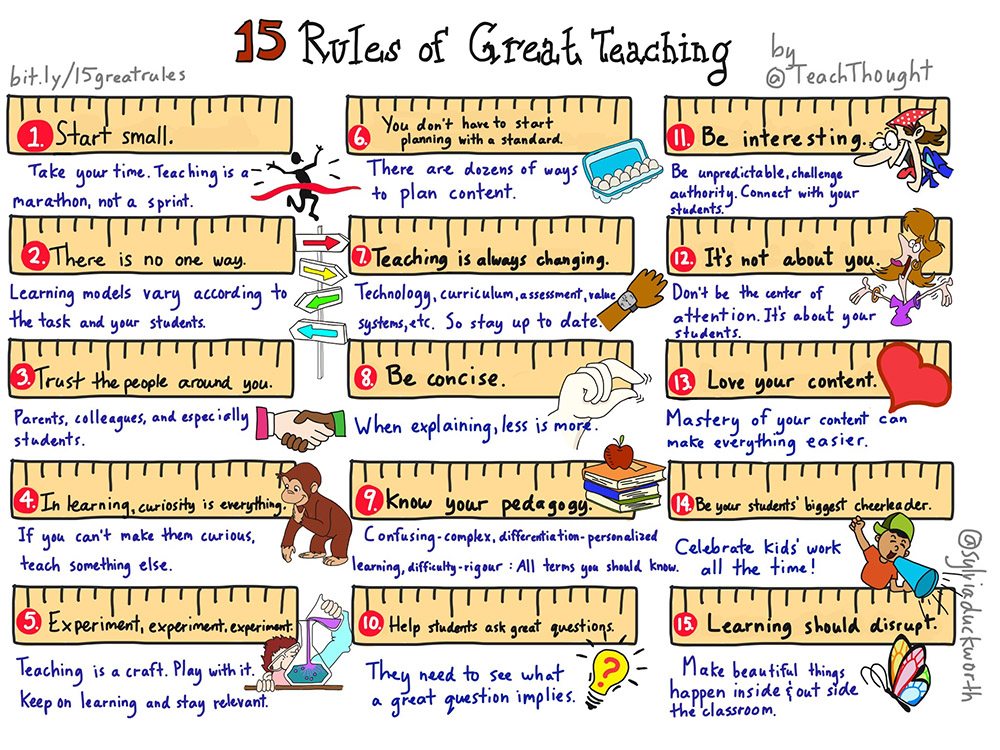
15 Rules Of Great Teaching
by TeachThought Staff
This post has been updated and republished
Recently, we’ve been thinking of universal truths in teaching.
Students should be first.
Don’t always start planning with a standard.
Questions matter more than answers.
Trust is a currency of a human classroom.
So we thought I’d gather twelve of them to start with. The idea of ‘good teaching’ is an idea we work toward in a variety of different ways, So then, here are some rules we might consider when making sense of this idea of what makes a teacher great. Thanks to Sylvia Duckworth for the great illustration, who went all out and added all 15 of our ‘rules.’
15 Rules Of Great Teaching
1. Start small.
This is how great things are built. Curriculum. Relationships. Portfolios. Take your time–this is a marathon, not a sprint.
2. Embrace that there is no one way.
Learning models, for example, are the new teaching strategy. Traditionally, teachers focus on ‘strategies’ to ‘teach.’ Reciprocal teaching. Lit circles. Accountable talk. Of course, these have value.
But the modern approach should have as much to do with what students access, when, how, and why as it does with ‘what students do in the lesson.’ Self-directed learning. Scenario-based learning. Project-based learning. Inquiry-based learning. Game-based learning. These are the strategies that matter first.
3. Trust the people around you.
Your students, first and foremost. But this goes for parents, and colleagues as well. It may not always work out the way you want, but if you’re the only one in control, there will be a net loss of capacity for the ecology of learning you participate in and serve.
4. In learning, curiosity is everything.
If you can’t make them curious, teach something else. I’ve theorized that there are stages to curiosity–and even things that make students curious. as well.
Taskmasters seek compliance. Good teachers seek engaged students. Great teachers–somehow, someway–find out what makes students click, and use it.
5. Experiment. Experiment. Experiment.
Teaching is a craft. Play with it. A little more of this, a little less of that. This new tool. Start here instead of there. Try this instead. Throw this out. Welcome this in.
Not only does this keep things fresh for students, but it keeps you sharp and relevant as an educator as this big world keeps on turning.
6. Don’t always start planning with a standard.
Know that it’s okay to think technology-first. Or curriculum first. Or standards. Or data. Or (ideally) student-first. There are dozens of ways to plan content. What matters is the power and sustainability of the learning as it manifests in the classroom.
7. Teaching is always changing.
Technology. Curriculum. Assessment. The value systems of students. Since these are always changing, your teaching be should as well.
8. Be concise.
When explaining, less is more.
9. Know your pedagogy.
Know the difference between confusing and complex. Between differentiation and personalized learning. Between project-based learning, and learning through projects. Between difficulty and rigor.
Between standards and curriculum. Between teaching and inquiry.
10. Help students ask great questions.
This can happen by modeling them, celebrating them, assigning points for them, curating and publishing them–whatever you can do to help students see what a great question implies. Here are 8 strategies to help students ask great questions, for starters.
11. Be interesting.
Be unpredictable. Challenge authority. Connect with students both through your teaching and in lieu of your teaching. Begin class with a bang–a crazy idea, interesting story, great song, funny joke. That said…
12. It’s not about you.
So don’t be the center of attention. Charismatic teachers are great–everybody loves them–but if your voice and personality dominate the classroom on a daily basis, things are out of balance.
Bonus
Here are 3 more to consider.
13. Love your content.
Stay up-to-date on changes. Be aware of the tricks, shortcuts, and interesting quirks of the content you teach. While teaching isn’t about content, mastery here can make everything else easier.
14. Be your students’ biggest cheerleader.
The be-tough-for-their-own-good bit may work for some, but celebrating kids works for everybody.
15. Know that learning should disrupt. (Read more here.)
Knowledge gained should result in personal change rather than mere academic progress. It should result in personal change for each student–and thus social change for all of us as a society.
If we build great schools and fill them with great technology and great teachers, but still send students home with no hope for the future–home to communities full of poverty, racism, intolerance, greed, waste, and apathy toward local ecologies, with no sense of place, historical legacy, or local and digital citizenship, then we know we have an institutionally-centered system.
When beautiful things happen–things we never could’ve imagined–both inside and outside the classroom, we’ll know we’re headed in the right direction.
12 Rules Of Great Teaching; image attribution flickr user flickeringbrad